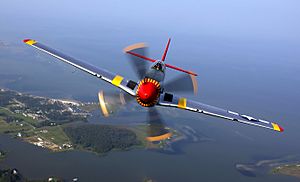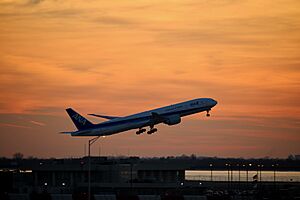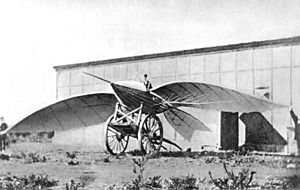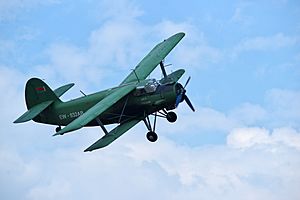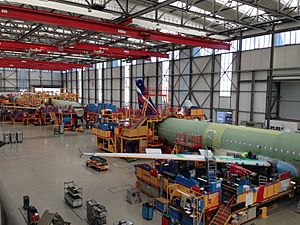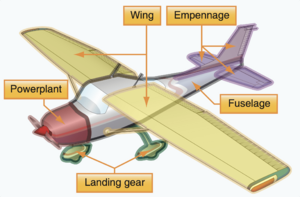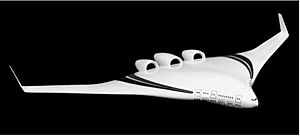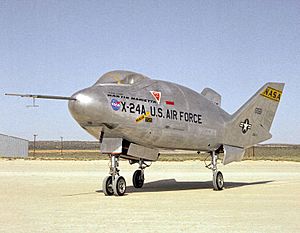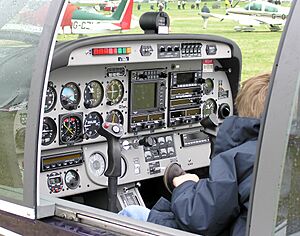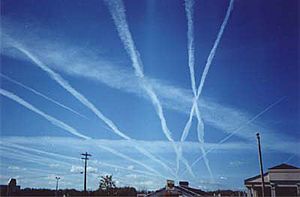Airplane facts for kids
Quick facts for kids Airplane |
|
|---|---|

The first flight of an airplane, the Wright Flyer on 17 December 1903.
|
|
| Classification | Vehicle |
| Industry | Various |
| Application | Transportation |
| Fuel source | Petrol, electricity, diesel, natural gas, hydrogen, solar |
| Powered | Yes |
| Self-propelled | Yes |
| Inventor | Wright Brothers |
| Invented | 1903 |
An airplane (also called an aeroplane or simply a plane) is a type of fixed-wing aircraft. This means its wings don't move like a helicopter's rotors. Airplanes move forward using a powerful push, called thrust. This thrust comes from engines like jet engines, propellers, or rocket engines.
Airplanes come in many sizes, shapes, and wing configurations. They are used for lots of different things. People use them for fun, like flying small planes as a hobby. They also carry people and goods all over the world. Airplanes are very important for the military and for research. Every year, billions of people travel by plane. Airplanes also move a huge amount of cargo. Most planes have a pilot inside, but some are controlled remotely or by computers, like drones.
The Wright brothers invented and flew the first airplane in 1903. This was the first time a machine heavier than air flew on its own and was controlled. They built on ideas from George Cayley (who designed modern airplane concepts in 1799) and Otto Lilienthal (who made many successful glider flights). Lilienthal's flights in 1891 are seen as the start of human flight. After World War I, airplane technology kept getting better. Airplanes played a big role in all major battles of World War II. The first jet aircraft was the German Heinkel He 178 in 1939. The first jet airliner, the de Havilland Comet, started flying passengers in 1952. The Boeing 707 was a very successful commercial jet, used for over 60 years.
Contents
History of Airplanes
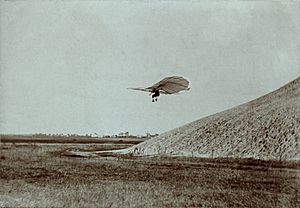
Early Flight Ideas
People have dreamed of flying for a very long time. Ancient stories, like the Greek legend of Icarus and Daedalus, talk about human flight. Around 400 BC, a Greek named Archytas supposedly built a flying device shaped like a bird. It was powered by steam and flew about 200 meters.
Some of the first recorded attempts at flying gliders were by Abbas ibn Firnas in the 9th century and Eilmer of Malmesbury in the 11th century. Both pilots got hurt during their flights. Leonardo da Vinci studied how birds fly in 1502. He designed a human-powered aircraft.
Building the First Airplanes
In 1799, George Cayley came up with the idea of a modern airplane. It would have fixed wings, separate systems for lift (to get off the ground), propulsion (to move forward), and control. Cayley built and flew model airplanes as early as 1803. He even built a glider that could carry a person in 1853.
In 1856, Jean-Marie Le Bris from France made the first powered flight. His glider was pulled by a horse on a beach. Other important people who flew gliders were John J. Montgomery, Otto Lilienthal, Percy Pilcher, and Octave Chanute.
Hiram Maxim built a huge machine in 1894 that weighed 3.5 tons. It had a 110-foot wingspan and two steam engines. Tests showed it could lift off the ground, but it was too hard to control.
Between 1867 and 1896, Otto Lilienthal from Germany made many successful glider flights. He was the first to do this repeatedly and with good records. Lilienthal's work helped create the modern wing design. His flights in 1891 are seen as the beginning of human flight. His "Lilienthal Normalsegelapparat" was the first airplane made in large numbers. His work greatly inspired the Wright brothers.
In the 1890s, Lawrence Hargrave studied wing structures. He created a box kite that could lift a person. His designs were used by many others.
The First Powered Flights
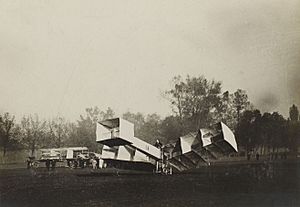
The Frenchman Clement Ader built his first flying machine, the Éole, in 1886. It looked like a bat and used a lightweight steam engine. On October 9, 1890, Ader tried to fly the Éole. It lifted off the ground and hopped about 50 meters, but he couldn't control it.
The American Wright brothers made their famous flights in 1903. The Fédération Aéronautique Internationale (FAI), which sets aviation records, recognizes this as "the first sustained and controlled heavier-than-air powered flight." By 1905, their Wright Flyer III could fly stably and be fully controlled for long periods. The Wright brothers said Otto Lilienthal was a big reason they decided to try manned flight.
In 1906, Alberto Santos-Dumont from Brazil made a flight that was claimed to be the first without help from a catapult. He flew 220 meters in less than 22 seconds, setting the first world record recognized by the FAI.
The Blériot VIII design from 1908 was an early airplane that looked like modern planes. It had movable tail parts to control turning and tilting. It also had a way to control rolling, either by twisting the wings or using ailerons. The pilot controlled it with a joystick and rudder bar. This design was important for his later Blériot XI plane, which crossed the English Channel in 1909.
World War I was a testing ground for airplanes as weapons. Planes were first used to watch enemy movements. Then they became war machines that could attack the enemy. The first time an airplane shot down another plane with a machine gun was in 1915. Famous pilots called fighter aces appeared, like Manfred von Richthofen, also known as the Red Baron.
After WWI, airplane technology kept improving. Alcock and Brown made the first non-stop flight across the Atlantic Ocean in 1919. The first international commercial flights started between the United States and Canada in 1919.
Airplanes were used in all major battles of World War II. They were key to military plans like the German Blitzkrieg, the Battle of Britain, and the American and Japanese aircraft carrier battles in the Pacific War.
The Rise of Jet Aircraft
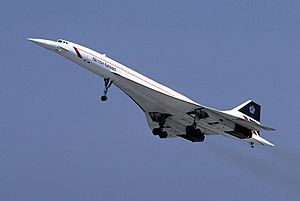
The first working jet aircraft was the German Heinkel He 178, tested in 1939. In 1943, the Messerschmitt Me 262, the first jet fighter used in battle, joined the German air force.
The first jet airliner, the de Havilland Comet, started flying passengers in 1952. The Boeing 707 was the first very successful commercial jet. It flew for over 50 years, from 1958 to 2010. The Boeing 747 was the world's largest passenger plane from 1970 until the Airbus A380 took its place in 2005.
Supersonic airliner flights, like those of the Concorde, were mostly limited to flying over water at very high speeds. This is because they create a loud sonic boom that is not allowed over most populated land areas. The Concorde was also very expensive to operate. After a deadly crash in 2000, the Concorde was taken out of service.
How Airplanes Fly: Propulsion
Airplanes need powerful engines to create thrust and fly.
Propeller Power
An aircraft propeller (or airscrew) turns the engine's spinning motion into a swirling airflow. This airflow pushes the plane forward or backward. A propeller has a spinning hub with two or more blades shaped like wings. These blades spin around a central line.
Three types of engines power propellers: reciprocating engines (piston engines), gas turbines, and electric motors. The amount of thrust a propeller makes depends on the area its blades cover as they spin. Propellers cannot go faster than about 0.6 times the speed of sound. If the blade tips go faster than sound, they create shock waves that make the propeller less efficient. Planes designed to go faster than this use jet engines.
Piston Engines
Piston engines in airplanes come in three main types: radial, in-line, and flat (or horizontally opposed).
- A radial engine has cylinders that stick out from a central part like spokes on a wheel. These were common before jet engines.
- An in-line engine has cylinders lined up one behind another. They can have any number of cylinders, but usually no more than six.
- A flat engine has cylinders that are opposite each other, lying flat.
Turboprop Engines
A turboprop engine is a type of gas turbine engine. It has an intake, a compressor, a combustor, a turbine, and a nozzle. This engine uses a shaft and gears to spin the propeller. The nozzle also provides some thrust, but most of the power comes from the propeller.
Electric Motors

An electric aircraft runs on electric motors. The electricity can come from fuel cells, solar cells, ultracapacitors, or batteries. Right now, most flying electric aircraft are experimental. However, some are now being made for sale.
Jet Power
Jet aircraft are powered by jet engines. These engines are used because they don't have the same speed limits as propellers. Jet engines are much more powerful for their size and weight. They are also quieter and work well at higher altitudes. Some special types of jet engines are the ramjet and scramjet. These engines use the plane's high speed to push air in and compress it before burning fuel. Rocket motors create thrust by burning fuel with an oxidizer and shooting gas out a nozzle.
Turbofan Engines
Most jet aircraft use turbofan jet engines. These engines use a gas turbine to power a large fan. This fan pushes air around the turbine, creating extra thrust. Some air also goes through the turbine. The ratio of air going around to air going through is called the by-pass ratio. Turbofans are a mix between jet engines (no bypass) and turboprops (mostly bypass).
Subsonic planes, like airliners, use high by-pass turbofans because they are good with fuel. Supersonic aircraft, like jet fighters, use low-bypass turbofans. At supersonic speeds, the air entering the engine must slow down before burning fuel, then speed up again. Combat planes might use an afterburner to get extra power for short times. Many jet planes also use thrust reversers to slow down after landing.
Ramjet Engines
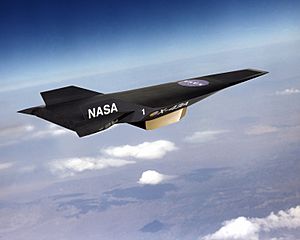
A ramjet is a jet engine with no major moving parts. It's useful for small, simple engines that need to go very fast, like in missiles. Ramjets need to be moving forward at a high speed before they can create thrust. So, they are often used with other engines or launched by something else. The Lockheed D-21 was a very fast ramjet-powered drone launched from another plane. A ramjet uses the plane's forward motion to force air through the engine. Fuel is added and burned, which heats and expands the air to create thrust.
Scramjet Engines
A scramjet is a special ramjet. It uses supersonic airflow inside the engine to compress air, mix it with fuel, burn it, and then shoot out the exhaust. This engine only works at supersonic speeds. The NASA X-43, an experimental scramjet, set a world speed record in 2004. It flew at Mach 9.7, which is almost 7500 miles per hour!
Rocket Engines
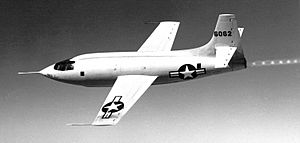
Jet planes use air from the atmosphere to burn fuel and push the plane. Rocket planes, however, carry their own oxidizer (like oxygen) on board. They burn fuel and oxidizer together, then shoot the hot gas out a nozzle to create thrust. The fuel can be liquid or solid.
During World War II, Germany used the Messerschmitt Me 163 Komet, a rocket-powered aircraft. The first plane to break the sound barrier in level flight was a rocket plane, the Bell X-1, in 1948. The North American X-15 broke many speed and altitude records in the 1960s. It helped engineers learn things for later aircraft and spacecraft. Military transport planes sometimes use rocket-assisted take offs to get off the ground quickly from short runways. Other rocket aircraft include spaceplanes, like SpaceShipTwo, which travel beyond Earth's atmosphere.
How Airplanes Are Made
Most airplanes are built by companies that plan to make many of them for customers. Designing and planning a plane, including safety tests, can take up to four years for smaller planes and even longer for big ones.
First, engineers use drawings, math, computer simulations, and wind tunnel tests to guess how the plane will behave. Computers help them draw and plan the aircraft. Small models of the plane or its parts are tested in wind tunnels to check how air flows around them.
Once the design passes these tests, the company builds a few test planes called prototypes. These are tested on the ground and then in the air. Aviation agencies often watch the first flight. Flight tests continue until the plane meets all requirements. Then, a government agency allows the company to start making the plane in large numbers. In the United States, this is the Federal Aviation Administration (FAA). In Europe, it's the European Aviation Safety Agency (EASA).
When parts of a plane are joined by welding, especially for aerospace or defense, they must meet very strict safety rules. Nadcap sets global quality standards for aerospace engineering.
For international sales, the plane also needs approval from the aviation agency in the country where it will be used. For example, planes made by the European company Airbus need FAA approval to fly in the U.S. Planes made by U.S.-based Boeing need EASA approval to fly in Europe.
Rules have helped make airplane engines quieter. This is because there's more air traffic near airports, causing noise pollution.
Some small planes can be designed and built by people at home as "homebuilts." Others can be put together using kits of pre-made parts.
Few companies make planes on a very large scale. However, building one plane involves dozens or even hundreds of other companies. These companies make the different parts that go into the plane. For example, one company might make the landing gear, while another makes the radar. These parts can come from all over the world. The parts are sent to the main factory where the plane is put together. For large planes, there might be separate assembly lines for parts like the wings and the body.
Once a plane is complete, it is carefully checked for any flaws. After inspectors approve it, the plane goes through more flight tests. This makes sure all systems work correctly and the plane flies well. Sometimes, planes are customized for a specific customer's needs.
Airplane Parts and Design

The Airframe
The main structural parts of a fixed-wing aircraft are called the airframe. The parts can change depending on the plane's type and what it's used for. Early planes were often made of wood with fabric wings. As engines became more powerful, more parts were made of metal. By the end of WWII, all-metal planes were common. Today, more and more parts are made from composite materials, which are strong and light.
Typical parts of an airframe include:
- Wings: One or more large horizontal wings. They are often shaped like an airfoil (like a bird's wing). As the plane moves forward, the wing pushes air downward, creating lift. This lift holds the plane in the air. Wings also help keep the plane stable from rolling side to side.

- Fuselage: A long, thin body, usually with smooth, rounded ends. The fuselage connects the other parts of the plane. It usually holds the pilot, passengers, cargo, and flight systems.
- Vertical Stabilizer (Fin): A vertical wing-like surface at the back of the plane, usually sticking up. The fin helps keep the plane stable when turning left or right (called yaw). It also holds the rudder, which controls turning.
- Horizontal Stabilizer (Tailplane): Usually at the back near the vertical stabilizer. This part helps keep the plane stable when tilting up or down (called pitch). It holds the elevators, which control pitch.
- Landing Gear: A set of wheels, skids, or floats that support the plane on the ground or water. On seaplanes, the bottom of the fuselage or floats support it on water. On some planes, the landing gear folds up during flight to reduce air resistance.
Wings: Shape and Number
The wings of a fixed-wing aircraft are flat surfaces that stick out from the sides. As the plane moves forward, air flows over the wings. The wings are shaped to create lift. This shape is called an airfoil.
Wing Structure
Early airplanes had flexible wing surfaces stretched over a frame. Larger, modern planes have rigid wing surfaces for extra strength. Whether flexible or rigid, most wings have a strong frame inside to give them shape and transfer lift to the rest of the plane. The main parts are spars (running from the body to the wingtip) and ribs (running from the front to the back edge).
Early airplane engines were not very powerful, so lightness was important. Also, early wings were very thin and couldn't hold a strong frame inside. So, until the 1930s, most wings needed outside supports like struts and wires. As engines got stronger, wings could be made heavy and strong enough without these supports. This type of wing is called a cantilever wing.
Wing Configuration
The number and shape of wings vary a lot. A single wing can be split by the fuselage into left (port) and right (starboard) wings. Sometimes, planes have more wings. The three-winged triplane was famous in WWI. Four-winged quadruplanes and other multiplane designs have not been very successful.
- A monoplane has one set of wings.
- A biplane has two sets of wings stacked one above the other.
- A tandem wing has two wings placed one behind the other.
When engines became more powerful in the 1920s and 30s, the unbraced (cantilever) monoplane became the most common type.
The planform is the shape of the wing when seen from above. For good airflow, a wing should be straight and long from side to side, but not very wide from front to back (high aspect ratio). But for strength and lightness, a wing should be short from side to side but still have enough area for lift (low aspect ratio).
At very high speeds (near the speed of sound), sweeping the wing backward or forward helps reduce drag from supersonic shock waves. A swept wing is simply a straight wing that is angled backward or forward.
The delta wing is shaped like a triangle. It can be used for different reasons. As a flexible Rogallo wing, it stays stable in the air and is used for ultralight aircraft and even kites. As a supersonic wing, it is very strong and has low drag, so it's often used for fast jets.
A variable geometry wing can change its shape during flight. The variable-sweep wing can be straight for takeoff and landing (which is efficient) and then sweep back for high-speed flight (which reduces drag). Other types of variable wings have been tested, but none have gone beyond research.
The Fuselage
A fuselage is the long, thin body of an airplane. It usually has smooth, rounded ends to help it move easily through the air. The fuselage can hold the flight crew, passengers, cargo, payload, fuel, and engines. Pilots fly manned aircraft from a cockpit at the front or top of the fuselage. The cockpit has controls, windows, and instruments. A plane might have more than one fuselage, or it might have booms (long structures) with the tail between them.
Wings vs. Bodies
Flying Wing
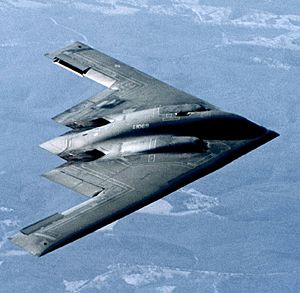
A flying wing is a plane that has no clear fuselage. Most of the crew, cargo, and equipment are inside the main wing structure.
Flying wings were studied a lot in the 1930s and 1940s. After WWII, some experimental designs used the flying wing idea, but they still had problems. Interest continued until the early 1950s, but these designs didn't offer huge advantages and had technical issues. So, "normal" planes like the Convair B-36 and B-52 Stratofortress were chosen instead. Because a flying wing needs a thick wing, it works best for slower planes. There's still interest in using it for tactical airlifter designs.
Interest in flying wings came back in the 1980s because they can be hard for radar to spot. Stealth technology uses shapes that only reflect radar waves in certain directions. This makes the plane hard to detect unless the radar receiver is in a very specific spot. This led to the Northrop B-2 Spirit stealth bomber. For the B-2, the main goal was stealth, not just how well it flew. Modern computer-controlled fly-by-wire systems helped fix many of the flying wing's flight problems, making it an efficient and stable long-range bomber.
Blended Wing Body
Blended wing body aircraft have a flattened, wing-shaped body that creates most of the lift. They also have separate wing structures, but these wings smoothly blend into the body.
So, blended wing body planes combine ideas from a futuristic fuselage and a flying wing. The benefits are efficient high-lift wings and a wide, wing-shaped body. This means the whole plane helps create lift, which can lead to better fuel economy.
Lifting Body
A lifting body is a plane where the body itself creates lift. Unlike a flying wing (which is mostly wing with little body), a lifting body is mostly body with little or no traditional wing. While a flying wing tries to be very efficient at subsonic speeds by removing non-lifting parts, lifting bodies usually try to reduce the drag and structure of a wing for subsonic, supersonic, and hypersonic flight, or for spacecraft re-entry. All these types of flight make it hard to keep the plane stable.
Lifting bodies were a big area of research in the 1960s and 70s. The U.S. built several famous lifting body rocket planes to test the idea. Interest faded when the US Air Force became less interested in manned missions. Major development stopped during the Space Shuttle design process because the shaped fuselages made it hard to fit fuel tanks.
Tail and Front Wings
A classic airfoil wing is not stable on its own and is hard to control. Flexible-wing planes often use a rope or the pilot's weight to stay in the right position. Some free-flying planes use special stable wing shapes or other clever systems, including electronic stability controls today.
To be stable and controllable, most fixed-wing planes have a tail section called an empennage. This includes a fin and rudder (for horizontal control) and a tailplane and elevator (for vertical control). These control surfaces can be adjusted to make flying easier. This setup is so common it's called the conventional layout. Sometimes, there might be two or more fins on the tail.
Some planes have a horizontal "canard" wing at the front, instead of the back. This front wing can help with lift, balance, or control, or all of these.
Controls and Instruments
Airplanes have complex flight control systems. The main controls let the pilot steer the plane in the air. They control the plane's attitude (how it rolls, pitches, and yaws) and engine thrust.
In manned aircraft, cockpit instruments give pilots information. This includes flight data, engine output, navigation, communications, and other systems.
Airplane Safety
When you look at deaths per passenger kilometer, air travel is about 10 times safer than traveling by bus or train. However, if you look at deaths per journey, air travel can seem more dangerous than car, train, or bus travel. This is why air travel insurance can be expensive. There's a big difference in safety between large airliners and smaller private planes. Airliners are much safer per mile than smaller planes.
Airplanes and the Environment
Like all activities that burn fuel, fossil-fuel-powered airplanes release soot and other pollutants into the air. They also produce Greenhouse gases like carbon dioxide (CO2). Airplanes also have some unique environmental impacts:
- Planes flying very high (mostly large jet airliners) release aerosols and leave contrails (white lines in the sky). Both can increase cirrus cloud formation. Cloud cover might have increased by up to 0.2% since aviation began.
- High-flying planes can also release chemicals that react with greenhouse gases at those altitudes. For example, nitrogen compounds react with ozone, increasing ozone levels.
- Most light piston aircraft burn avgas, which contains tetraethyllead (TEL). Some lower-compression piston engines can use unleaded gasoline. Turbine engines and diesel engines (which don't need lead) are used on some newer light aircraft. Some non-polluting light electric aircraft are already being made.
Another environmental impact of airplanes is noise pollution. This is mainly caused by planes taking off and landing.
See Also
 In Spanish: Avión para niños
In Spanish: Avión para niños
- Aircraft flight mechanics
- Aviation
- Fuel efficiency
- List of altitude records reached by different aircraft types
- Rotorcraft
Images for kids


